RICH PEOPLE IN JAPAN
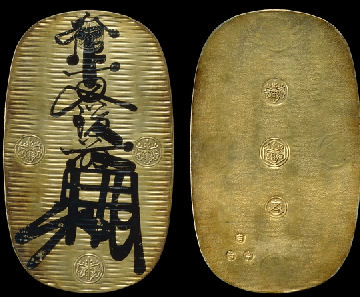
18th century gold bar The word "tycoon" is an anglicized version of the Japanese word “taikun”, the title used to describe the shogun to foreigners. According to Merrill Lynch annual World Wealth Report there were 1.24 million dollar millionaires in Japan in 2004, a 10 percent increase from 2001. In 2008, the collective wealth of Japan’s 40 richest people was valued at $89.9 billion, up $10.7 billion from the previous year. The group is getting older. Their average age was 66, including nine octogenarians, three more than two years ago.
Each year the government announces Japan's highest taxpayers. These people are regarded as biggest earners of that year. In 2004 the top taxpayer in Japan was Tatsuro Kiyohara, the chief of operations for an investment firm. He paid ¥3.7 billion in taxes, which means that he earned around ¥10 billion for year, or around $85 million.
Four Japanese tycoons — architect Tadao Ando, Suntory Chairman Nobutada Saji, Softbank Chairman Masayoshi Son, and Fast Retailing Chairman Tadayashi Yanai — were named by Forbes Asia on its list of Asia's top 48 philanthropists in 2012. The magazine said the March earthquake and tsunami that devastated northeastern Japan "has weighed heavily on the minds of Japanese billionaires." [Source: Kyodo, June 23, 2011]
In June 2008, two Japanese men were detained by Italian financial police for try trying to enter Switzerland from Italy with $134 billion worth of undeclared U.S. bonds, mostly Treasury bonds. The men tried to conceal the bonds which including 249 U.S. Treasury bonds with a face value of $500 million each in suitcases with false bottoms. It was not clear what the men were up to. Authorities let them go. When contacted the U.S. Treasury said that it never issued bonds worth $500 million.
Good Websites and Sources: 2009 Forbes Article on Japan’s Richest 40 Business People forbes.com ; 2009 Forbes Article on Japanese Billionaires forbes.com ; Internet Post on “How to Get Rich in Japan? community.livejournal.com ; Wikipedia bio on Masayoshi Son Wikipedia . Uniqlo uniqlo.com/us
Middle Class Society in Japan
Japan is home of one of the world's wealthiest and most egalitarian societies. Wealth is spread relatively evenly. Not long ago 90 percent of Japanese referred to themselves as middle class. The gap between the highest and lowest incomes is the smallest among advanced nations. Many factory employees and construction workers fit comfortably into the middle class, able to afford nice houses and cars.
There is less emphasis on being number one and winning in Japan than in the United States. Individuals that do excel at something are taught that their specialties or skills should be done for the benefit of the group not just for themselves.
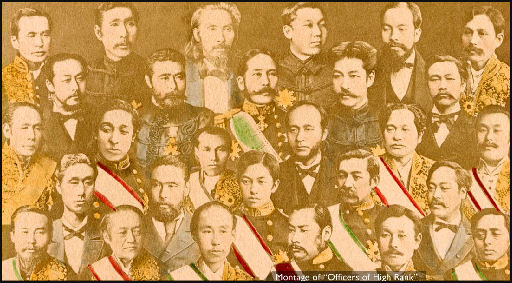
19th century aristocracy
Japanese Aristocracy
The Japanese aristocracy was stripped of its land, wealth and status according to the terms of the post-war constitution. One man from a noble family told the Washington Post, “After the war my mother had to cook for the first time."
The aristocracy lives on at Tokyo's Kasumi Kaikan, an "aristocracy club" made up of 950 eldest sons and grandsons of Japan's old nobility. Regarded as the most exclusive group in Japan and made of people who would be ruling Asia if Japan had won World War II, its doesn't accept business tycoons, corporate presidents or real estate developers no matter how many billion they have.
At Kasumi Kaikan's penthouse headquarters, members can shoot pool, dress in traditional costumes and compose traditional 31-syllable “waka” poems surrounded by ancient books, samurai swords and priceless vases and scrolls. The club sponsors classes in traditional Japanese art forms such as calligraphy and incense smelling. Although wives and daughters are not allowed in the club bar, they do much of the clubs volunteer and cultural work.
Members of the Kasumi Kaikan dressed Emperor Akihito when he claimed the Japanese throne in 1990. They also dressed Crown Prince Naruhito when he married Princess Masako in 1993.
Billionaires in Japan
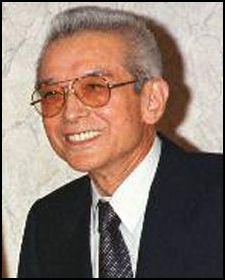
Nintendo's Hiroshi Yamauchi Japan had 27 billionaires on the Forbes list of 793 billionaires in 2006. They had a combined worth of $67 billion, less than India’s 27 billionaires who has an estimated worth of $99 billion.
The countries with the most billionaires in 1996 were: 1) the United States (129); 2) Germany (53); 3) Japan (37); 4) Hong Kong (14); 5) Thailand (12); 6) France (11) and 7) Mexico and Indonesia (10 each).
Richest people in Asia in 2001 (net worth in $billion): 1) Li Ka-shing of Hong Kong (12.6); 2) Raymond Walter and Thomas Kwok of Hong Kong (11.5); 3) Yasuo Takei of Japan (8.3); 4) Nobutada Saji of Japan (7.7); 5) Azim Premji of India (6.9); 6) Lee Shau Kee of Hong Kong (5.9); 7) Kyosuke Kinoshita, chairman of Acom Co. (5.6); 8) Masoyoshi Son of Japan (5.6); 9) Yoshitaka Fukuda of Japan (5.2); 10) Tadashi Yanai of Japan (4.9). [Source: Forbes]
The economic crisis in 2008 and 2009 clearly hurt Japan’s rich, The combined worth of the 40 richest people in Japan declined from $89.9 billion in 2008 to $69.5 billion in 2009.
Japan is the home of the world's seventh richest woman. Worth about $3.2 billion, Shigeko Shino is the head of the Meiko, a huge conglomerate founded by her father that owns real estate, hotels and an airport.
Richest People in Japan in 2008 and 2009
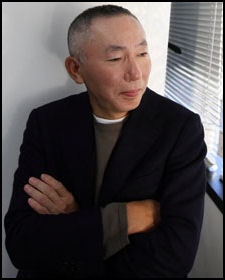
Tadashi Yanai The person at the top of the rich list in Japan has been different every year since 2005. Tadashi Yanai — the president of Fast Retailing, the owner of the Uniqlo clothes store chain — was at the top of Forbes ranking of Japan’s richest people in 2009, with a net worth of $6.1 billion. He was in sixth place the year before. Robust sales at Uniqlo during the economic crisis in 2008 and 2009 increased his worth by $1.4 billion over 2008 while the net worth of most other super rich people in Japan fell during the same period.
Uniqlo, short for Unique Clothing Warehouse, is a chain of clothing stores that sells cheap but fashionable clothes and is somewhat similar to international “fast fashion” brands like The Gap, Sweden’s H&M, and Spain’s Zara chains. Regarded as the moving force behind the “cheap chic” movement in Japan, Uniqlo has been immensely successful, racked up huge profits and revolutionized Japanese fashion. Many young people buy cheap sweaters and shirts at Uniqlo with expensive accessaries such as Hermes scarves and Gucci leatherware.
The first Uniqlo opened in Hiroshima in 1985. At first the store had difficulty drawing attention because it clothes were regarded as too cheap, The chain took off when a Uniqlo store opened up in the hear of trendy Harajuku in Tokyo. Shoppers and reporters swamped the grand opening and suddenly it was fashionable.
These days Uniqlo generates interest with trendy print and television ads, some designed by the same advertising company that launched the Nike "Just Do It" ads. Its make huge profits by keeping it costs down.
Uniqlo has stores in Britain, Japan, South Korea, China, France and the United States. It opened its first store in Paris in 2007 and opened a global flagship store, with a 20-meter-wide entrance and clothes sin cylindrical showcases on Oxford Street in London. It opened a global flagship store in Soho in New York City in 2006. It as plans to expand into India and Russia.
In 2008, former Nintendo chairman Hiroshi Yamauchi, was selected by Forbes as the richest man in Japan with a net worth of $7.8 billion, $3 million more than previous year thanks to the soaring value of Nintendo stock on the back of brisk Wii video game console sales. He was ranked the third wealthiest person in Japan by Forbes 2007 with a net worth of $4.8 billion. He moved up 11 spots that year, again benefitting from the surge in Nintendo share prices on the success of the Wii game console. In 2009, Yamauchi, slipped to third with $4.5 billion.
Akira Mori
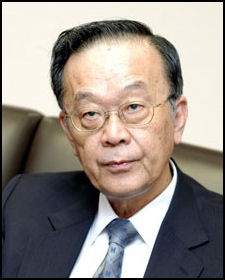
In 2008, Real estate developer Akira Mori was selected by Forbes as the 2nd richest man in Japan with a net worth of $7.7 billion, $2.2 billion more than the previous year when he was named the second wealthiest person in Japan, with a net worth of $5.5 billion. It was the first time he had been ranked No.1 Forbes said his ranking due in part to “Japan’s fastest rise in average land prices in 16 years. Mori died at the age of 77 of heart failure in March 2012. At that time he had a net worth of $1.9 billion according to Forbes.
Mori was head of Mori Trust Co. and founder and chairman of Mori Building Co., Japan's biggest closely held developer. In 2007 Mori was named Asian businessman of the year by Fortune magazine. Inspired by the architect Le Corbusier, he has made a name of himself building complete developments where people can “live, work and play” among buildings with homes, work places, retail outlets, hotels and entertainment all grouped together. He developed Tokyo’s Omotesando Hill and financed the 101-story Shanghai World Financial Center. He is best known for the ritzy $2.2 billion Roppongi Hills project in Tokyo, which includes a 54-story office tower, four apartment buildings and a hotel. The development, which took about two decades to complete, made Mori famous outside of Japan. "I want to change the character of the city," Mori told Bloomberg News in 2003. "I want to change the lifestyle of the people." [Source: Bloomberg, Kyodo, March 14, 2012]
Mori was born on Aug. 24, 1934, in Kyoto. Mori attended Tokyo University after World War II and had originally had ambitions of being a novelist that explored existential themes. He worked for a while in his family home-rental business and didn’t like it much so he convinced his father, Taikichiro Mori, an economics professor, to go into urban development instead. The two of them established Mori Building Co. in 1959 to buy and sell real estate when Minoru was still a student at the University of Tokyo. Soon, his younger brother, Akira, joined the company. The business that Mori founded with his father began with a single rice shop but grew into a $12 billion empire of 121 structures, most of them around the southern Toranomon-Roppongi international business district in Tokyo, by the late 2000s.
Mori Building built and rented office buildings during the boom leading up to the 1964 Olympics. After the oil shock of the 1970s, the company decided tearing down old buildings was too costly, and started to build higher-quality structures in new locations.When their father died in 1994, the brothers split their inheritance into separate firms. In 1993 Mori took over as president. By focusing on long-terms projects and avoiding speculation be escaped the collapse of the bubble economy in the 1990s and weathered the Asian financial crisis in 1997. Akira, 75, heads Mori Trust Co., which owns buildings that compete with Roppongi Hills for tenants, including the Tokyo Shiodome Building near Tokyo Bay. Akira is Japan's third-richest person and has a net worth of $3.5 billion, Forbes says.
Mori created his development business with his father and two brothers. They prevailed in an insider-dominated business against the politically well-connected, analysts say, by correctly reading the future and creating developments that were right for the times. Mori also has received high marks for perseverance and patience. Mori’s first big high-rise project, Ark Hill, which opened in 1986 took 17 years to complete, much of that time spend cutting through red tape and persuading hundreds of reluctant residents to move. Mori lived with his family in Roppongi Hills and practiced tai chi in the square there when weather permitted.
Mori Projects

Mori's Shanhai skyscraper Mori built the 492-meter-high (1,600-feet-high) World Financial Center in Shanghai. Intended to be the world highest building, it was completed in 2008 at a cost of $1.1 billion. The bold, sharp-edged structure has been called a Chinese samurai sword. While the building was under construction a huge circle near the top was replaced with a rectangle to avoid any comparisons with the rising sun of Japan.
Mori bought the land on which the World Financial Center was built in 1994. The skyscraper was originally supposed to be started in 1996 and completed in 2001, but was slowed by delays, the most crippling of which was the Asian financial crisis in 1997. Now things are better: tenants seem willing to pay the $3 a square meter per day rents, the highest commercial rents charged in Shanghai.
In Tokyo, Mori developed the Omotesando Hill shopping complex — with multiple open shopping levels and an artificial brook — and the $4 billion, 27-acre Roppongi Hills development. These have won high marks for living up to Mori’s “live, work and play” goals and helping earthquake-prone Tokyo overcome its fear of skyscrapers and also for taking nature into consideration with rooftop gardens and parks that attract fireflies and cicadas but keep away crows.
Mori looks upon himself more as a social engineer than a developer or tycoon. “I think I’m not in the business of profit-making. I’m closer to an artist, because I’m active in this real world of making cities.” He plans to build 10 more huge complexes in downtown Tokyo, including one that will include the tallest building in Japan. He also has plans to build similar developments in Singapore and Bangkok and is also checking out Vietnam, South Korea and Russia and getting the billions he needs for the projects from Chinese and Middle East sovereign wealth funds. .
Yoshiaki Tsutsumi
Yoshiaki Tsutsumi, a Japanese real estate mogul, was listed by Forbes magazine as the world’s richest man three times. In 1995 and 1996 he was the 3rd richest man in the world behind Bill Gates and Warren Buffet. Worth an estimated $9 billion in 1996, he was believed to be worth $20 billion before the bottom fell out the real estate market in the early 1990s.
Tsutsumi headed a company called Kokudo. At his peak he controlled an empire that included railways, ski resorts, hotels and the Seibu Lions baseball team. He had homes all over the globe and flew around in a helicopter checking his projects. He was very influential in the Japanese Olympic bureaucracy and played a big role in the staging of the 1998 Olympics in Nagano.
After graduating from Waseda University Tsutsumi took over a company run by his father. His father was a greatly admired man who bowed low on a tatami mat in the 1950s, saying “I’ll entrust everything to from now on.”
Tsutsumi made his fortune through real estate speculation and development during the Bubble Economy years in the 1970s and 80 and the lost it as the bubble burst in the 1990s. He was known for giving orders on the smallest of details and being quick to shout, “You’ve been fired.” From childhood Tsutsumi was taught to carry himself like a ruthless tycoon, treating everyone like shit including his own brother and top aids who either had no contact with him or went out of their way to avoid him.
In March 2005, Tsutsumi was arrested in connection with falsifying financial reports and insider trading in connection with the sale of Seibu railway’s shares. The scandal involved hiding shares of railway to jack up the value of the railway’s shares. The evidence that Tsutsumi was involved in the scheme was strong. One Seibu executive with knowledge of the scandal committed suicide.
Book: “The Brothers” by Lesley Downer (Random House) is about the Tsutsumis. It was a New York Times Book of the Year in 1995.
Billionaire Monk in Japan
Kazuo Inamori, the founder of Japan's no. 2 telephone company and a $6 billion computer chips manufacturer, suddenly decided to retire in 1997 and become a monk. Famous for combining religion teachings with business techniques, Inamori reportedly was inspired by a book about religion that given to him when he was bedridden with tuberculosis at the age of 13 and thought he was going to die.
In spite of failing to get into one of Japan's prestigious universities, Inamori managed to secure a chemical engineering degree and get at a job for a company that made insulators. Angered by the company’s lack of enthusiasm about his passion for ceramics, he quit in 1959 at he age of 27 and formed a new company with seven coworkers called Kyocera Co. with money from a $10,000 loan. By 1997, Kyocera Co. was a $6 billion company that dominated the world market for ceramic casings for computer chips.
When Kyocera became successful, Inamori became an inspirational speaker, lecturing and writing about topics such as "For People and for Profit" and "A Passion for Success." Kyocera employees revered him as if he were a religious figure, attending daily philosophy meetings at 7:00am before work began. One employee told the New York Times, "I felt electricity when he was near."
Masayoshi Son, the Japanese Bill Gates
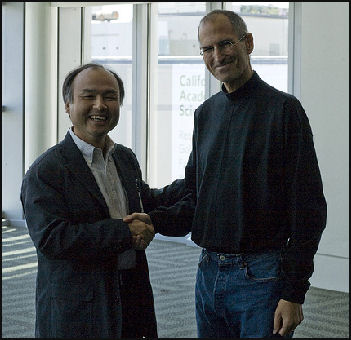
Son with Apple's Steve Jobs Masayoshi Son, who is sometimes called the Japanese Bill Gates, was the richest man in Asia and the 8th richest man in the world in 2000, with a net worth of $17 billion, but his net wealth plummeted after the bursting the Internet bubble in 2000 to $5.6 billion and $1.1 billion in 2002, when he was world’s 386th richest man.
Son is owner of Softbank, a conglomerate that is invested in Internet and E-business enterprises all over the world. Unassuming and balding, he look more like a salaryman than a high-tech mogul. Son was ranked the second wealthiest person in Japan by Forbes in August 2007 with a net worth of $5.45 billion. He was first in 2006. He was once worth $76 billion during the dot.com boom.
Son was born in Kyushu to Korean immigrants. Koreans are discriminated against in Japan and Son endured his share of taunting and bullying when he was in school. He built up his strength by putting metal weights in his shoes and moved to the United States while still in his school.
Son insisted on using his Korean family name rather than Yasumoto, the Japanese name his parents had taken. Because of his Korean ancestry Son was not considered a Japanese citizen. He eventually was granted citizenship based on the fact that his wife had changed her name to Son and if one Japanese person has the last name of Son then it must be a Japanese last name.
Son is a graduate of Berkeley. At Berkeley, he imported electronic arcade machines from Japan and made his first $1 million designing the software for Sharp's electronic translator and organizer, the Wizard. He is famous for his 19-hour workdays and was so engaged in one deal he almost missed his own wedding.
See Softbank, Economics, Industry, Electronics
Other Famous Rich Guys in Japan

Suntory's Nobutada Saji Yasuo Take was Japan's richest person, Asia's third richest person and the world's 37th richest person in 2000. Worth an estimated $8 billion, he made his money in consumer finance and was the owner of Takefuji Corp.
Suntory President Nobutada Sajii was 37th on the Forbes list in 2002. His family fortune that year was $7.1 billion.
One of the biggest supporters of African relief programs is a Japanese philanthropist named Ryoichi Sasakawa who made his fortune from parimutuel betting on speedboat racing, and later shipbuilding.
Japanese industrialist Ryoei Saito made headlines in 1990 when he paid $82.5 million for Van Gogh's “Portrait of Dr. Gachet” and two years later bought Renoir's “Le Moulin de la Galeet” for $78.1 million. In 1994 Saito lost control of his troubled paper company and was convicted on bribery charges. At last report the painting were being stored in a bank vault.
Image Sources: 1) British Museum, 2) Visualizing Culture, MIT Education 3) skyscraper, Shangai government, 4) rich guys, justsharethis blog
Text Sources: New York Times, Washington Post, Los Angeles Times, Daily Yomiuri, Times of London, Japan National Tourist Organization (JNTO), National Geographic, The New Yorker, Time, Newsweek, Reuters, AP, Lonely Planet Guides, Compton’s Encyclopedia and various books and other publications.
Last updated January 2013
